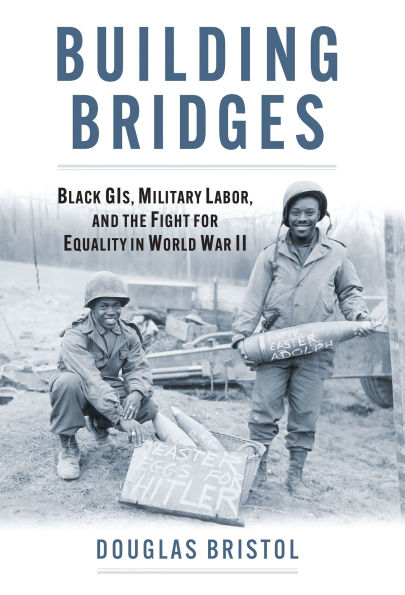The previously overlooked story of how the labor of Black GIs helped win the war and advanced racial integration in the US armed forces.
More than 80 percent of Black GIs in World War II served behind the front lines. At the beginning of the war, segregation policies maintained physical separation of Black and white GIs and only allowed Black soldiers to do simple, menial work, maintaining a false sense of racial inferiority. But the mechanization of armed forces during World War II demanded more skilled laborers behind the front lines. The Army Service Forces, created in March 1942, turned to Black GIs to solve the serious manpower shortage and trained them for jobs previously done only by white GIs. In Building Bridges, author Douglas Bristol tells the story of how military necessity led to unprecedented changes in the employment of Black troops. These changes had unanticipated consequences. American military leaders adopted a new racial discourse that emphasized the rights and potential of Black GIs. The new opportunities also exposed racial discrimination, giving Black GIs and their allies more leverage to demand better treatment.
Black GIs built bridges, roads, and runways. They repaired engines and radios. They transported bombs, bullets, food, gasoline, and water to hard-pressed soldiers on the front lines. Their numbers, skills, and necessity only grew as the war continued. By the end of the World War II, Black GIs had cracked the glass ceiling in the racialized military hierarchy behind the front lines and became indispensable to keeping the American war machine running around the globe.
The previously overlooked story of how the labor of Black GIs helped win the war and advanced racial integration in the US armed forces.
More than 80 percent of Black GIs in World War II served behind the front lines. At the beginning of the war, segregation policies maintained physical separation of Black and white GIs and only allowed Black soldiers to do simple, menial work, maintaining a false sense of racial inferiority. But the mechanization of armed forces during World War II demanded more skilled laborers behind the front lines. The Army Service Forces, created in March 1942, turned to Black GIs to solve the serious manpower shortage and trained them for jobs previously done only by white GIs. In Building Bridges, author Douglas Bristol tells the story of how military necessity led to unprecedented changes in the employment of Black troops. These changes had unanticipated consequences. American military leaders adopted a new racial discourse that emphasized the rights and potential of Black GIs. The new opportunities also exposed racial discrimination, giving Black GIs and their allies more leverage to demand better treatment.
Black GIs built bridges, roads, and runways. They repaired engines and radios. They transported bombs, bullets, food, gasoline, and water to hard-pressed soldiers on the front lines. Their numbers, skills, and necessity only grew as the war continued. By the end of the World War II, Black GIs had cracked the glass ceiling in the racialized military hierarchy behind the front lines and became indispensable to keeping the American war machine running around the globe.

Building Bridges: Black GIs, Military Labor, and the Fight for Equality in World War II
224
Building Bridges: Black GIs, Military Labor, and the Fight for Equality in World War II
224
Product Details
| ISBN-13: | 9780700639014 |
|---|---|
| Publisher: | University Press of Kansas |
| Publication date: | 06/24/2025 |
| Series: | Studies in Civil-Military Relations |
| Sold by: | Barnes & Noble |
| Format: | eBook |
| Pages: | 224 |
| File size: | 3 MB |
